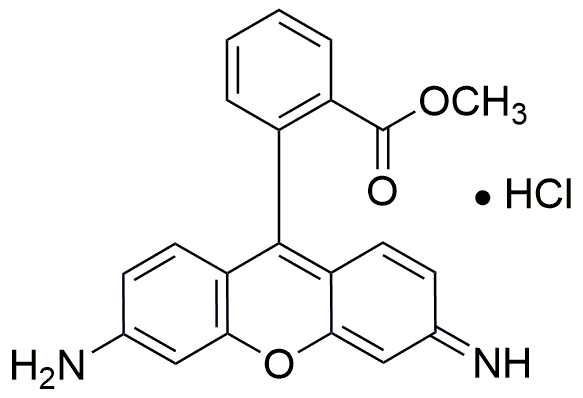Rhodamine 123 is widely utilized in research focused on:
- Fluorescent Tracers: Commonly used in biological imaging, Rhodamine 123 serves as a fluorescent tracer to visualize cellular processes, making it invaluable in cell biology and pharmacology.
- Drug Delivery Studies: Its properties allow researchers to track the distribution of drugs within organisms, aiding in the development of targeted therapies and improving treatment efficacy.
- Mitochondrial Studies: This compound is particularly effective in studying mitochondrial function and dynamics, helping researchers understand energy metabolism and its implications in diseases.
- Environmental Monitoring: Rhodamine 123 is used in environmental science to trace water pollution and assess the movement of contaminants in aquatic systems, providing critical data for remediation efforts.
- Diagnostic Applications: In medical research, it is employed in assays to detect cellular viability and apoptosis, offering insights into cancer research and potential therapeutic interventions.
General Information
Properties
Safety and Regulations
Applications
Rhodamine 123 is widely utilized in research focused on:
- Fluorescent Tracers: Commonly used in biological imaging, Rhodamine 123 serves as a fluorescent tracer to visualize cellular processes, making it invaluable in cell biology and pharmacology.
- Drug Delivery Studies: Its properties allow researchers to track the distribution of drugs within organisms, aiding in the development of targeted therapies and improving treatment efficacy.
- Mitochondrial Studies: This compound is particularly effective in studying mitochondrial function and dynamics, helping researchers understand energy metabolism and its implications in diseases.
- Environmental Monitoring: Rhodamine 123 is used in environmental science to trace water pollution and assess the movement of contaminants in aquatic systems, providing critical data for remediation efforts.
- Diagnostic Applications: In medical research, it is employed in assays to detect cellular viability and apoptosis, offering insights into cancer research and potential therapeutic interventions.
Documents
Safety Data Sheets (SDS)
The SDS provides comprehensive safety information on handling, storage, and disposal of the product.
Product Specification (PS)
The PS provides a comprehensive breakdown of the product’s properties, including chemical composition, physical state, purity, and storage requirements. It also details acceptable quality ranges and the product's intended applications.
Certificates of Analysis (COA)
Search for Certificates of Analysis (COA) by entering the products Lot Number. Lot and Batch Numbers can be found on a product’s label following the words ‘Lot’ or ‘Batch’.
*Catalog Number
*Lot Number
Certificates Of Origin (COO)
This COO confirms the country where the product was manufactured, and also details the materials and components used in it and whether it is derived from natural, synthetic, or other specific sources. This certificate may be required for customs, trade, and regulatory compliance.
*Catalog Number
*Lot Number
Safety Data Sheets (SDS)
The SDS provides comprehensive safety information on handling, storage, and disposal of the product.
DownloadProduct Specification (PS)
The PS provides a comprehensive breakdown of the product’s properties, including chemical composition, physical state, purity, and storage requirements. It also details acceptable quality ranges and the product's intended applications.
DownloadCertificates of Analysis (COA)
Search for Certificates of Analysis (COA) by entering the products Lot Number. Lot and Batch Numbers can be found on a product’s label following the words ‘Lot’ or ‘Batch’.
*Catalog Number
*Lot Number
Certificates Of Origin (COO)
This COO confirms the country where the product was manufactured, and also details the materials and components used in it and whether it is derived from natural, synthetic, or other specific sources. This certificate may be required for customs, trade, and regulatory compliance.


